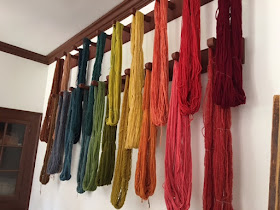On a warm and sunny March day recently, my friend author Cynthia Howerter and I (and her husband and my son!) ventured out to Colonial Williamsburg. I have lived in the area almost twenty years and have been a CW member for much of that time and have visited many times. But the weaver's shop was never open on the days I visited (or I didn't have time to stop). But blessedly, on this day, a talented weaver was present and we got to go inside and also watch a session.
The weaver has to push the long wooden rod forward to move the two intersecting sets of yarn/thread. Below is a closeup of the intersecting threads on the loom.
Weavers, in England, were traditionally men. As our weaver continued the process, she was producing the cream-colored fabric on the larger roll, below! I think it is really lovely. This cloth produced pieces that would then be stitched together to form blankets, e.g., for soldiers.
Wool, cotton, and linen would have been the materials used to weave textiles in colonial America. I love the soft natural color of all three.
Those skeins on the left would have been dyed with natural dyes. They produced beautiful colors, don't they? Check out Colonial Williamsburg's post about their Weaver.
For more about textiles production in Colonial America, check out Pegg Thomas's post on Fulling Houses.
Carrie Fancett Pagels, Ph.D., is an ECPA bestselling and award-winning author of over a dozen Christian historical romances. Her novel, Saving the Marquise's Granddaughter (Pelican, 2016) is set in the 1740s in France, the Palatinate of Germany, and in Colonial America. Carrie is the owner/administrator of Colonial Quills blog and founder of Colonial American Christian Writers group. Her website is www.carriefancettpagels.com







I have a friend who weaves beautiful linens. Always amazes me. Thanks for sharing!
ReplyDeleteIt was amazing to see that cloth continue to grow in length, Angela, and come together!
DeleteOh wow, CARRIE, to actually see a demonstration of a weaver, how exciting! Thanks for sharing.
ReplyDeleteBlessings, Tina
It was really thrilling, Tina, to finally get to see the weaver work with her loom! I'd never been there while they were doing it, before.
DeleteCarrie, thank you fr this wonderful post! This information is helpful for my current WIP. Lovely photos as well! Blessings! Someday, Lord willing, I'll get back to visit CW. :)
ReplyDeleteGlad that was helpful, Elaine!
DeleteI am amazed and in awe of weavers. Such great talent and skill. Thank you for sharing this information. :-)
ReplyDeleteGood thing I didn't have to weave anything, Melissa! It looks like strenuous work. Glad you enjoyed the post!
DeleteThat's a massive loom! I have several friends who are weavers, but on a smaller scale. I've tried weaving, and I think I would enjoy it, if only I didn't have to warp the loom. THAT is an art form, and a whole lot of work. The actual weaving is fun, though.
ReplyDeleteYes, it is a huge loom, Pegg! I wish you could get down here to CW to see it. I am so impressed by all the cool things you do and I love the shawl you made!
DeleteGood job, Carrie!I plan to be back in Williamsburg for the second week in May to do more research and will look forward to finding this weaver's shop. So you live in the area?
ReplyDeleteBlessings,
Elva Cobb Martin
Pres. ACFW-SC Chapter, Anderson, SC
www.elvamartin.com
Williamsburg is a great place to visit in May and to do research, Elva! I live in Yorktown, which is not far from Williamsburg.
Delete